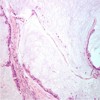Colloid Carcinoma of the Pancreas: A Distinct Pancreatic Neoplasm with Good Prognosis. Report of a Case
Abstract
Context: Colloid carcinoma is considered a distinct type of pancreatic neoplasia with specific histopathological and molecular features, and a better prognosis. Case report We present the case of a patient with a 15cm locally invasive colloid carcinoma of the pancreas, in which an aggressive surgical approach achieved no evidence of disease 24 months after surgery. Conclusions If an accurate diagnostic approach and surgical resection are performed, the 5-year survival rate can reach 60%. Presence of invasive intraductal papillary mucinous neoplasm has been reported, and this can affect the prognosis. Adjuvant therapy has not demonstrated improvement of survival in surgically-resected patients.
Downloads
References
Andea A, Klimstra D, Cheng J, et al. Colloid carcinoma of the pancreas. Curr Diagn Pathol. 2004;10:61-68.
Adsay N, Pierson C, Sarkar F, et al. Colloid (Mucinous Noncystic) carcinoma of the pancreas. Am J Surg Pathol. 2001;25:26-42. [PMID 11145249]
Yopp AC, Katabi N, Janakos M, et al. Invasive Carcinoma Arising in Intraductal Papillary Mucinous Neoplasms of the Pancreas. A matched control study with conventional pancreatic ductal adenocacinoma. Ann Surg 2011;253:968-974.
Vo T, Xing Y, Meric-Bernstam F, et al. Long-term outcomes in patients with mucinous, medullary, tubular, and invasive ductal carcinomas after lumpectomy. Am J Surg. 2007;194:527-531.
Waters JA, Schnelldorfer T, Aguilar-Saavedra JR, et al. Survival after resection for invasive intraductal papillary mucinous neoplasm and for pancreatic adenocarcinoma: a multi-institutional comparison according to American Joint Committee on Cancer Stage. J Am Coll Surg 2011;213:275-283.
Tanaka M, Chari S, Adsay V, et al. International consensus guidelines for management of intraductal papillary mucinous neoplasms and mucinous cystic neoplasms of the pancreas. Pancreatology. 2006;6:17-32. [PMID 16327281]
Levi E, Klimstra DS, Andea A, et al. MUC1 and MUC2 in pancreatic neoplasia. J Clin Pathol. 2004;57:456-462.
Adsay NV, Merati K, Nassar H, et al. Pathogenesis of colloid (pure mucinous) carcinoma of exocrine organs: coupling of gel-forming mucin (MUC2) production with altered cell polarity and abnormal cell-stroma interaction may be the key factor in the morphogenesis and indolent behaviour of colloid carcinoma in the breast and pancreas. Am J Surg Pathol. 2003;27:571-578. [PMID 12717243]
Schnelldorfer T, Sarr MG, Nagorney DM, et al. Experience with 208 resections for intraductal papillary mucinous neoplasm of the pancreas. Arch Surg. 2008;143:639-646. [PMID 18645105]
Crippa S, Salvia R, Warshaw AL, et al. Mucinous cystic neoplasm of the pancreas is not an aggressive entity: lessons from 163 resected patients. Ann Surg. 2008;247:571-579.
Turrini O, Waters JA, Schnelldorfer T, et al. Invasive intraductal papillary mucinous neoplasm: predictors of survival and role of adjuvant therapy. HBP (Oxford). 2010;12(7):447-455. [PMID 20815853]

Copyright (c) 2014 Ines Rubio-Perez, Elena Martin-Perez, Luis Sanchez-Urdazpal, Paloma Corbaton, Eduardo Larrañaga

This work is licensed under a Creative Commons Attribution 4.0 International License.
As a member of Publisher International Linking Association, PILA, iMedPub Group’s JOP follows the Creative Commons Attribution License and Scholars Open Access publishing policies. Journal of the Pancreas is the Council Contributor Member of Council of Science Editors (CSE) and following the CSE slogan Education, Ethics, and Evidence for Editors.